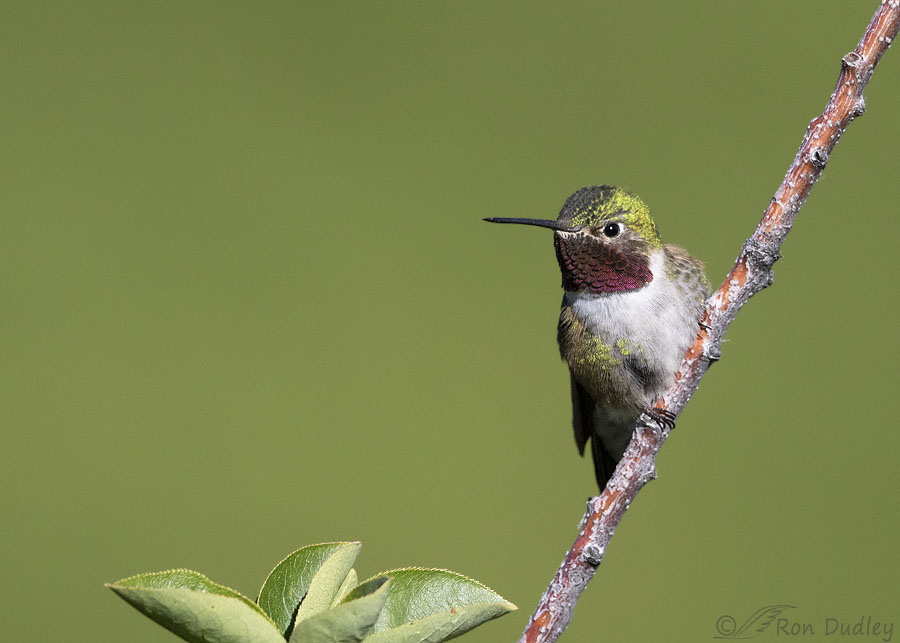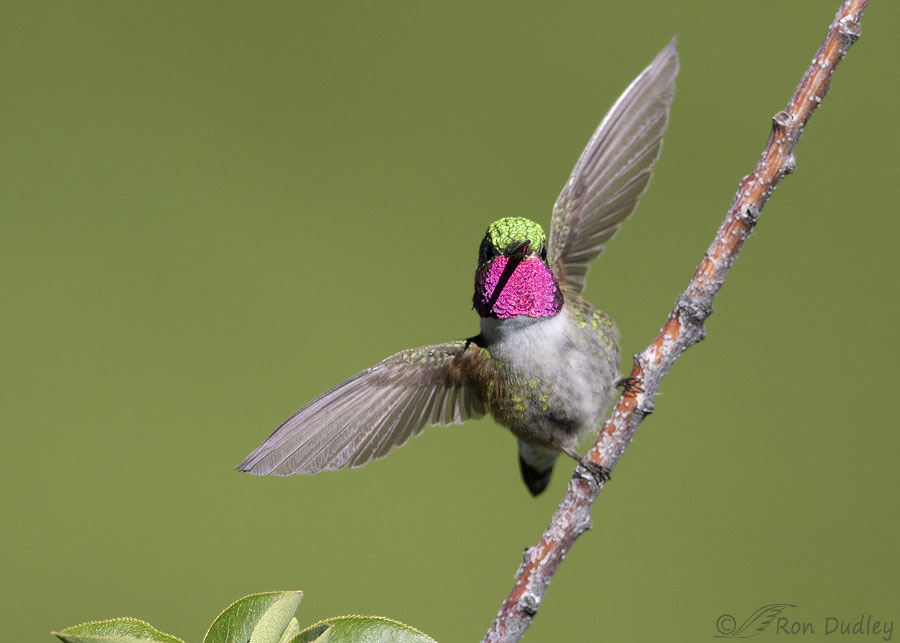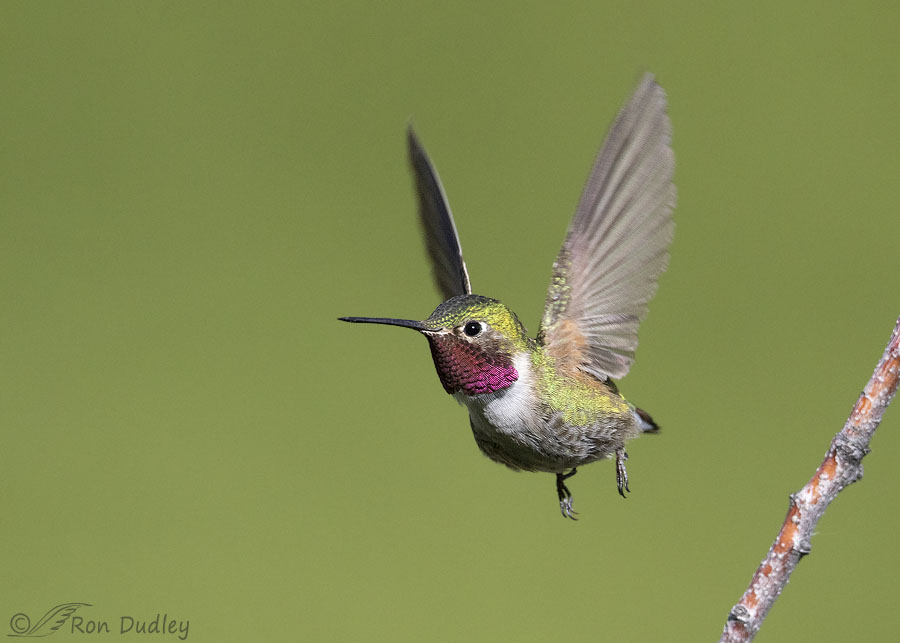Plus some interesting information on the presumed functions of the gorget.
In several recent posts I’ve mentioned the frustrations of capturing the flashing gorget colors of male hummingbirds. When Broad-tailed Hummingbirds are facing me directly the gorget colors light up like a Christmas tree. But with the bird facing me directly like that its bill all but disappears and I can barely see the eyes which typically have no catch lights. Those kinds of shots are rarely appealing.
But when a male hummer turns his head a little so we can see both the bill and the eye better most or all of the gorget colors instantly disappear. That frustrating phenomenon of physics was illustrated for me recently in a series of three shots as a Broad-tailed Hummingbird took off from his diagonal perch in the mountains.

1/5000, f/5.6/ ISO 800, Canon 7D Mark II, Canon EF 500mm f/4L IS II USM + EF 1.4 III Extender, not baited, set up or called in
While he was perched and looking to his left and right for approaching intruders the gorget always showed very little color or none at all.

1/5000, f/5.6/ ISO 800, Canon 7D Mark II, Canon EF 500mm f/4L IS II USM + EF 1.4 III Extender, not baited, set up or called in
But as he was leaving the perch during takeoff he faced me directly for a nanosecond and that gorgeous color appeared as quickly as a flashing strobe light. But we see more of the shadow of the bill than we do of the bill itself and what little we can see of his eyes looks like little more than photon-sucking black pits. Not good.

1/5000, f/5.6/ ISO 800, Canon 7D Mark II, Canon EF 500mm f/4L IS II USM + EF 1.4 III Extender, not baited, set up or called in
And then those traits did another flip-flop as the hummer was leaving the perch – suddenly we can see the bill and the eye clearly but the gorget color has mostly disappeared. In fact more often than not the gorget has even less color than this, it just looks black.
I realize that all of this is old hat to most birders and hummingbird lovers but I thought it was interesting to see it illustrated in a series of photos taken only a tenth of a second apart.
If you’ve ever wondered about the function(s) of the hummingbird gorget you might find this info from Wikipedia interesting.
- “A number of social functions have been suggested for the gorget. It may aid in mate attraction or in resource defense. It may signal social status or allow species to identify conspecifics. Among hummingbirds, gorgets are typically found only on males. In the rare instances where they are found on females, they appear to serve primarily for signaling threats. Young hummingbirds, which need to intrude on adult territories to feed once they have fledged, all lack gorgets. This may help to make them less visible or less threatening to adult birds.”
Ron


The breadth of knowledge reflected in the comments are humbling and I admit that I did not know what “gorget” meant. I think it is great that you have an example of all three portrait angles. I do not see them often enough to get many images of the hummers let alone that wonderful flash of red. I am happy to have captured what I have, but definitely not finished with the pursuit.
Agreed, Jane. The pursuit is never ending.
Great attitude on display in all these postures.
I do really like these sequences with hummers as it gives the opportunity to see and study the gorget and the rest of the hummer in its differing reflective presentations. (I’m pretty sure I like all bird sequences.)
I thought hummers were incredible enough before I read what Dan shared below, utterly fantastic!
Thank you, Dave. Yes, Dan contributes a lot to posts like this and it’s much appreciated.
I too find that fascinating. Beautiful pictures. And thank you Dan for all of the info!
Thanks, Jean. Dan’s a fount of interesting and reliable bird info.
Fascinating stuff, photography and comments. So many wondrous things about hummers: color (or the illusion of it), getting sustenance from flower nectar, flight capabilities, wing sounds in flight, ability of such a small package to survive long, cold winter nights (at least the Anna’s here in Washington state). The only downside I can think of is they don’t rid my vegetable garden of aphids.
Lyle, they do eat aphids – particularly females who are feeding chicks, but obviously not enough of them. They also eat gnats, biting and otherwise, but once again not nearly enough of them!
Yet another beautiful, interesting, educative and down-right fascinating post.
I did know that there is no such thing as a ‘blue’ feather, but was totally clueless as far as the precision involved in iridescence.
Some day I will stop being so earth-shatteringly ignorant. Or more likely I will die trying.
As always, huge thanks to you and those who comment.
“Some day I will stop being so earth-shatteringly ignorant. Or more likely I will die trying.”
There’s just too much out there to know, EC. But the effort to try sure makes life interesting…
You can watch a male hummingbird turn its head slightly to flash color to a potential mate or a rival. But, it all happens because of the amazing structure of the gorget feathers. (Red is often used during mate attraction or as a sign of aggression. Watch Red-winged Blackbirds feeding together, all the while keeping the red wing patch covered, unless one jostles another and suddenly the red flashes as a warning.)The feather barbs of the gorget are flattened and aligned in one plane and together combine to make a mirror, a very special mirror. All light is absorbed at most angles, making the gorget look black. At just the right angle, light is strongly reflected and the bright color is visible. This is a very pure color almost of a single wavelength and only visible at a very particular angle. Each species has a particular wavelength that is reflected that is slightly different from others. Thus, the gorget color is slightly different for different species. The hummingbird may not be aware of the particular structure of his feathers, but he certainly knows how to use them.
Interesting stuff, Dan. Thanks for providing it.
I often wonder about the purposes of iridescence in other species, Black-billed Magpies for instance. Endlessly fascinating to ponder.
Very interesting, Dan.
Can you elucidate the physics of that effect in which the reflection off the feathers is specular (reflects at only one angle vs. diffuse reflecting at all angles) AND is wavelength specific? Is it a macro effect due to the physical structure of the feathers themselves or more a chemical/molecular level effect of the feather structure?
~interested optical guy, Art
Iridescence is produced by a combination of the barbule structure and the arrangement of melanin granules and air bubbles trapped within, and the overlaying keratin. In hummingbirds, the barbules are flattened and very precisely arranged with respect to each other and the melanin granules within are also very precisely arranged and of the same particle size such that only one wavelength is reflected at only at one angle. A slightly less tight arrangement of melanin (and/or more variation in size) can cause other types of iridescence, such as that over the back of a hummingbird or that of a magpie or Brewer’s Blackbird. A still different arrangement can produce not iridescence, but the structural blue of bluebirds, jays, etc. (There are no blue pigments in birds.) Feathers are not simple and there is a vast diversity of kinds and structure across the avian world.
Double thanks to you today, Dan!
WOW. It really is amazing how different it is. And you got a sharp wing in the second one. Congratulations, professor. Hard to do.
Congratulations, professor. Hard to do.
Thanks, Arwen. The soft wings in that last shot was a depth of field issue at f/5.6.
That is exceptional photography Ron. He almost looks like he’s a professional hummingbird model hired to pose for you. Beautiful photos with gorgeous color.
Thank you, Everett. Believe me, no money changed hands (or wings)….
I’ve experienced the same thing, Ron. I think your third photo is just about as good as it gets in terms of maximizing gorget color while keeping the eye catch light and a good perspective of the bill. I also like that perspective on the gorget because the variation across the spectrum from almost black to color and back to dark again helps give the surface more texture and depth whereas the flashing gorget always looks very flat and, although bright, much less interesting. Just my preference.
You make a valid point about the gorget, David. Too much of a good thing sometimes.
Weird and scary year indeed–no “Great white combines” in southern Utah, of course, but also hardly any hummingbirds, bees, and very few butterflies—most folks I talk to
who are observers of the small wildlife are HOPING that they have , for some reason, retreated to higher altitudes–but it’s much cooler than usual in the lowlands——-
I agree, Kris – it’s incredibly scary. I’ve seen many reports of similar observations in many other areas of the world.
Thanks for this post. They are amazing creatures. I recently re-watched 2 Nature series programs about Humming Birds and they have made some incredible adaptation to the geography where they live. The ones high up in the Andes are most interesting. I love most anything that flies with the exception of yellow jackets and maybe a few other insects, but my favorite is the hummer. I think flying is magic.
Betty, can you imagine not having hummingbirds around? I can’t but most of the world is in exactly that situation since they’re only found in the Americas today (although the fossil record indicates that they originated in Eurasia).
Beautiful…… Interesting on the possible uses of the gorget – it totally dominates the 2nd photo – always something to learn. Needed the smile on a dreary morning.
Interesting on the possible uses of the gorget – it totally dominates the 2nd photo – always something to learn. Needed the smile on a dreary morning.  Great White Combine last evening – again – 2.3″ of precip with an inch coming in about 20 minutes…….sighhhhhh. “White heads” starting to show in some wheat fields along the road indicating previous damage. A REALLY weird year!
Great White Combine last evening – again – 2.3″ of precip with an inch coming in about 20 minutes…….sighhhhhh. “White heads” starting to show in some wheat fields along the road indicating previous damage. A REALLY weird year!
Thanks, Judy. Sounds like you’re taking damaging hail in stride – not easy for a farmer to do. I remember my folks asking me as a teenager several times if I wanted to eventually take over the farm and even at that age I was sure of my answer – a resounding NO! Hail was a significant part of the reason I felt that way. It devastated us more than once. And hail insurance was so damned expensive…
At least we won’t starve as in the old daya!
Yup, you’re an optimist. The best choice for a farmer, that’s for sure.
Beautiful color…when it flashes! I do like that little ‘take-off leap’ in the third photo but it does illustrate the quickness of the fading iridescence on the top of the head. Interesting about the fledglings…something I never thought about as they are territory-less…they would have to be in full’ camo-mode’. The workings of nature…always a solution. Interesting post.
“something I never thought about as they are territory-less”
I had never considered it either but it makes perfect sense. Thanks, Kathy.